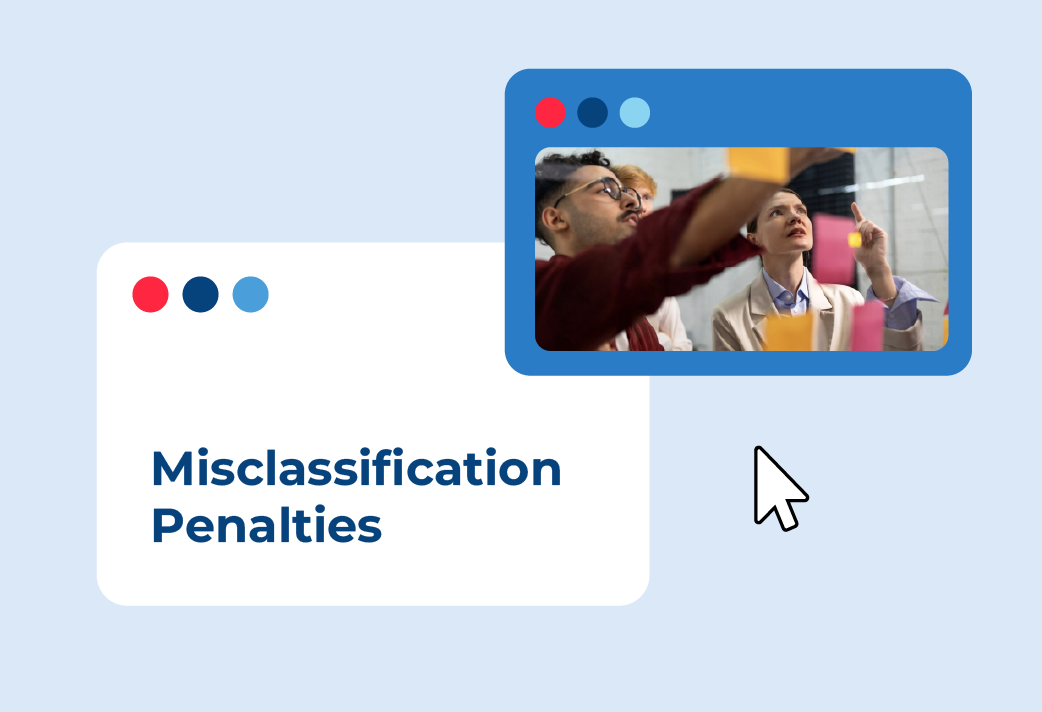Employee misclassification is a serious issue in the US, with, according to one estimate, up to 30% of US businesses incorrectly categorizing workers as independent contractors rather than employees. This mistake can result in substantial financial penalties in the US, as well as higher court legal disputes and reputational damage.
As federal and state regulations continue to evolve, understanding the IRS misclassification penalties and relevant independent contractor laws is crucial for businesses to ensure compliance.
What Is Employee Misclassification?
Employee misclassification occurs when an employer incorrectly classifies a worker as an independent contractor rather than an employee. This can be intentional or accidental, but regardless of intent, misclassification compliance risks can be severe.
Proper classification, therefore, is critical for ensuring that workers receive the correct wages, benefits, and legal protections.
Why Misclassification Is a Critical Issue
The consequences of misclassification extend beyond financial penalties and encompass a whole range of potential problems for businesses and their workers. Misclassified workers may be denied key employment benefits, such as overtime pay, health insurance, and unemployment benefits.
Additionally, misclassification deprives the government of tax revenue, prompting the need for strict enforcement by agencies such as the IRS and the Department of Labor (DOL) to ensure proper government oversight.
Overview of Employee Classification in the US
Employee vs. Independent Contractor: Key Differences Between Employees and Contractors
Employees in the US are entitled to minimum wage protections, overtime pay, and employer-sponsored benefits, whereas independent contractors work on a project basis and handle their own taxes and benefits.
Common Tests for Classification
Several tests are used to determine whether a worker is an employee or an independent contractor. The two most widely used are the IRS Common Law Test and the Economic Realities Test.
Common Law Test
The IRS uses a three-factor test, considering behavioral control, financial control, and the relationship of the parties, in order to determine classification.
If an employer exerts significant control over a worker’s duties, maintain financial liability for loss or damages, and is the worker is tied to an exclusive or long-term relationship with the employer, then the worker is likely an employee.
Economic Realities Test
Used by the DOL and courts, this test evaluates whether a worker is economically dependent on the employer. If so, they should be classified as an employee rather than an independent contractor.
The Importance of Proper Classification: What are the Penalties for Employee Misclassification?
Proper classification protects workers’ rights, ensures businesses comply with tax laws, and prevents costly legal battles. Misclassification can trigger IRS misclassification penalties, civil lawsuits, and reputational harm.
Financial Penalties and Back Taxes
- Unpaid Payroll Taxes – Employers found guilty of misclassification must pay back taxes, including unpaid Social Security, Medicare, and unemployment taxes. These liabilities can accumulate rapidly, leading to substantial financial burdens.
- Fines and Interest on Back Payments – In addition to tax liabilities, employers face fines and accrued interest on unpaid wages and benefits. The IRS imposes penalties based on whether the misclassification was intentional or accidental.
Legal and Civil Penalties
- Lawsuits for Unpaid Wages and Benefits – Misclassified workers may sue for unpaid overtime, minimum wage violations, and denied benefits. Class-action lawsuits can significantly increase financial exposure.
- Additional Damages Under Federal and State Laws – Beyond financial penalties, employers may be required to pay liquidated damages and attorneys’ fees. Some states impose stricter laws, further increasing penalties.
Reputational Damage
- Public Perception and Brand Impact – Misclassification scandals can damage a company’s reputation, affecting customer trust and investor confidence. Negative publicity can lead to long-term business setbacks.
- Loss of Trust Among Employees and Stakeholders – Employees who feel exploited due to misclassification may leave the company, leading to high turnover rates and a loss of skilled talent.
Criminal Penalties
- Severe Cases of Willful Misclassification – Employers who willfully misclassify workers to evade taxes or avoid labor laws may face criminal prosecution. Cases of fraud or repeated violations can escalate to criminal charges.
- Potential Imprisonment for Fraudulent Activities – In extreme cases, employers found guilty of intentional misclassification and tax evasion can face jail time under federal and state laws.
Specific US Laws Governing Employee Classification
Employee classification in the United States is governed by a complex framework of federal and state laws.
These regulations define the criteria for distinguishing between employees and independent contractors and outline the legal consequences of misclassification. Understanding and complying with these laws is essential for any company operating in the U.S., particularly those engaging remote or flexible workforces.
Fair Labor Standards Act (FLSA)
The Fair Labor Standards Act (FLSA) is the primary federal law regulating wage and hour standards for employees in the US. Overseen by the U.S. Department of Labor (DOL), the FLSA is meant to ensure that covered employees receive at least the federal minimum wage and are compensated correctly for overtime.
Misclassification under the FLSA typically occurs when a worker is wrongly classified as an independent contractor and therefore denied these and other protections. Penalties for noncompliance may include:
- Back pay for unpaid minimum wage or overtime
- Liquidated damages, often equal to the amount of back pay owed
- Civil monetary penalties, particularly in cases of repeated or willful violations
- Legal fees and litigation costs, if the case is taken to court
- Higher scrutiny going forward by labor and tax officials
Internal Revenue Code (IRC)
The Internal Revenue Code (IRC) governs how individuals and businesses are taxed in the U.S., and the Internal Revenue Service (IRS) enforces the classification rules related to tax withholding and reporting.
When a worker is misclassified as an independent contractor, the employer may fail to:
- Withhold income tax
- Pay Social Security and Medicare taxes (FICA)
- Pay federal unemployment tax (FUTA)
This can result in:
- IRS audits and investigations
- Payment of back taxes, interest, and penalties
- Potential criminal liability in cases of intentional fraud
The IRS “Common Law Test” thus focuses on behavioral control, financial control, and the nature of the relationship to assess correct worker classification. Employers found in violation may also lose eligibility for safe harbor protections under Section 530 of the Revenue Act of 1978, meaning they will be eligible for higher back payments if they fail to meet employment responsibilities.
State-Level Worker Classification Laws
While federal laws provide the baseline, many U.S. states have developed their own employee classification rules that can be stricter than federal standards. Businesses must be aware of and comply with state-level requirements in every state where they engage workers.
California’s AB-5 Law
California’s Assembly Bill 5 (AB-5), enacted in 2020, is one of the most far-reaching state laws on employee classification. It codifies the “ABC Test” for determining whether a worker is an independent contractor or an employee:
- (A) The worker is free from control and direction in the performance of the work
- (B) The worker performs work that is outside the usual course of the hiring entity’s business
- (C) The worker is engaged in an independently established trade, occupation, or business
Failure to meet all three prongs means the worker must be classified as an employee, not an independent contractor. This has had profound effects on gig economy companies (e.g., Uber, Lyft), trucking firms, and content creators. Violations can lead to similar penalties as those at the federal level.
Other State-Specific Rules
Several other states have introduced their own criteria or tests for worker classification. Notable examples include:
- New York – Uses a hybrid test combining elements from the Common Law and economic realities test, which regulators use to aggressively target misclassification, especially in construction and service sectors.
- New Jersey – Also uses the ABC Test, and employers found in violation may be publicly listed if reported and found guilty.
- Massachusetts – Enforces one of the strictest ABC Tests in the country, making it extremely difficult to classify a worker as an independent contractor.
States may also impose additional penalties, including:
- Suspension or revocation of state contracts
- Debarment from bidding on public projects
- Enhanced penalties for repeated or willful misclassification
- Personal liability for company officers or executives
Given the overlapping and constantly evolving nature of federal and state laws, maintaining compliance in the U.S. requires not only legal awareness but also proactive HR and payroll strategies.
Partnering with a trusted global employment solutions provider and expert on local tax and labor regulations, like INS Global, can be the best way to help mitigate risk and manage classification correctly across jurisdictions.
Risks of Misclassification for Employers in the US
Audits and Investigations
IRS and Department of Labor (DOL) Audits – The IRS and DOL actively investigate misclassification cases, imposing back taxes, fines, and penalties on non-compliant businesses.
State-Level Enforcement Actions – State labor departments conduct random audits and investigations, further increasing employer risk.
Back Payments and Retroactive Penalties
Employers may be required to pay back wages, benefits, and penalties dating back several years, causing significant financial strain.
Impact on Employee Morale and Retention
Misclassification affects employee trust and job satisfaction, leading to higher turnover rates and recruitment challenges.
Steps to Avoid Employee Misclassification
- Conducting Regular Classification Audits – Routine audits help identify potential misclassification risks and ensure compliance with evolving laws.
- Understanding Federal and State Laws – Employers must stay informed about federal and state-specific worker classification regulations to avoid costly mistakes. If a worker or company feels in doubt about their working relationship, Form SS-8 may be requested to seek clarification. However, this may put companies under close surveillance, inviting the risk of penalties for noncompliance.
- Seeking Legal and Professional Guidance – Including consulting employment law experts who can provide guidance on classification rules and help businesses implement best practices and partnering with Employer of Record (EOR) Services – EORs handle worker classification, payroll, and compliance, ensuring businesses avoid legal pitfalls.
- Documenting Worker Relationships Clearly
- Establishing Written Contracts – Clearly defined contracts outline job scope, responsibilities, and payment terms from day one of the hiring process.
- Maintaining Consistent Practices – Employers should apply consistent policies across all worker classifications to ensure compliance.
Challenges and Considerations
Navigating the Complexity of State and Federal Regulations
One of the most significant challenges for U.S. employers is the dual layer of regulatory compliance at the federal and state levels. While federal bodies like the IRS and the Department of Labor have their own guidelines, many states have independent classification standards that are often stricter and more detailed.
For example, a worker classified as an independent contractor under the IRS’s Common Law Test may still qualify as an employee under California’s ABC Test. This fragmentation means that businesses operating across multiple states must:
- Monitor varying definitions of employment status
- Comply with state-specific reporting and filing requirements
- Stay current with frequent legislative changes and court rulings
Failing to align practices with local laws increases the risk of audits, penalties, and employee claims, making it critical for companies to centralize compliance monitoring and invest in expertise familiar with multi-jurisdictional frameworks.
Balancing Workforce Flexibility with Legal Compliance
Modern businesses increasingly rely on flexible staffing models to remain agile and competitive. Independent contractors, freelancers, and consultants offer speed and scalability, especially in project-based industries like tech, design, and professional services.
However, with this flexibility comes the risk of crossing legal thresholds into misclassification. Employers must carefully evaluate who controls how and when work is performed, whether the worker uses company tools or platforms, and how the permanence and exclusivity of the working relationship may develop over time.
Overreliance on independent contractors without proper classification checks can blur legal lines. To strike the right balance, companies should implement clear contractual agreements and maintain role-specific documentation that reinforces proper classification from the start.
Adapting to Evolving Workforce Trends
The rise of the gig economy, remote work, and digital freelancing has reshaped traditional employment relationships. With platforms facilitating on-demand services and global hiring made easier by technology, many companies now engage workers from across the U.S.—often without fully understanding the legal implications.
This new normal requires companies to:
- Reassess and adapt internal classification policies
- Account for remote workers’ locations and associated state laws
- Evaluate whether the nature of remote work arrangements shifts the classification threshold
As the U.S. government continues to scrutinize gig economy platforms and pass new legislation, staying ahead of these changes is crucial. Companies must be proactive, not reactive, in updating their workforce policies.
Why Proper Worker Classification Matters
Proper worker classification is not just a legal formality but a core element of business risk management. Beyond financial damage, misclassification undermines employee trust and can erode employer credibility with clients, partners, and investors.
To prevent this, organizations should conduct routine internal audits, ensure HR teams are trained on classification rules, and integrate legal oversight into the hiring process.
Final Thoughts on Avoiding Misclassification Risks: Partnering with INS Global
Avoiding misclassification isn’t about avoiding hiring flexibility but about hiring responsibly, legally, and strategically. By taking a proactive, well-informed approach, companies can build strong, agile workforces without exposing themselves to unnecessary legal and financial risk.
Why INS Global is Your Partner of Choice for Avoiding Misclassification Penalties in the US
At INS Global, we help companies expand and operate across borders with confidence. Our expansion services in the United States simplify the complexities of compliance, minimize misclassification risk, and provide a fast, reliable route to workforce deployment.
With INS Global, you benefit from:
- Full legal employment compliance in all 50 states
- Expert management of worker classification, payroll, and benefits
- Scalable hiring solutions for full-time, remote, or project-based workers
- Clear, transparent support for onboarding, contracts, and ongoing HR administration
In a regulatory landscape as complex and fast-changing as the U.S., correct worker classification is more important than ever. Contact INS Global and find out how, with expert US EOR support by your side, you can focus on growth while we handle the legal and administrative complexity.





SHARE